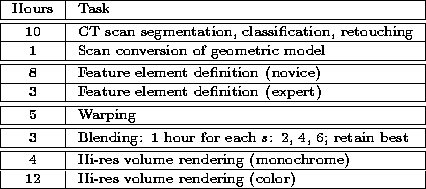 volumes comprises all the steps shown on
figure 1. Our experience is that about 24 hours are
necessary to turn design into reality on an SGI Indigo 2:
volumes comprises all the steps shown on
figure 1. Our experience is that about 24 hours are
necessary to turn design into reality on an SGI Indigo 2:
Our color figures show the source volumes, target volumes, and halfway morphs for three morph sequences we have created.
The human and orangutan volumes shown in figures 5a and 5c were warped using 26 element pairs to produce the volumes of figures 5b and 5d at the midpoint of the morph. The blended middle morph appears in figure 5e.
Figures 6 and 7 show two examples of color morphs, requiring 37 and 29 element pairs, respectively. The UI, displaying the elements used to control the morph of figure 6, is shown in 6d.
The total time it takes to compose a 50-frame morph sequence for
 volumes comprises all the steps shown on
figure 1. Our experience is that about 24 hours are
necessary to turn design into reality on an SGI Indigo 2:
volumes comprises all the steps shown on
figure 1. Our experience is that about 24 hours are
necessary to turn design into reality on an SGI Indigo 2:

We have presented a two step feature-based technique for realistic and smooth metamorphosis between two 3D models represented by volumes. In the first step, our feature-based warping algorithm allows fine user control, and thus ensures realistic morphs. In addition, our warping method is amenable to an efficient, adaptive approximation which gives a 50 times speedup. Also, our technique corrects the ghosting problem of [2]. In the second step, our user-controlled blending ensures that the rendered morph sequence appears smooth.